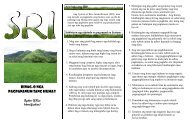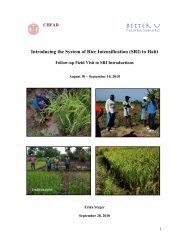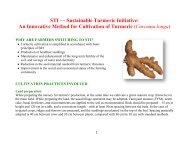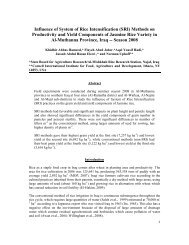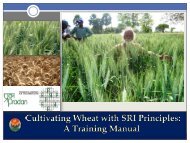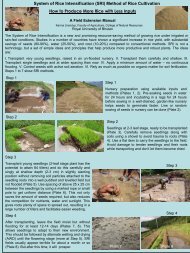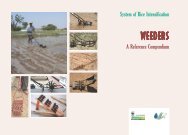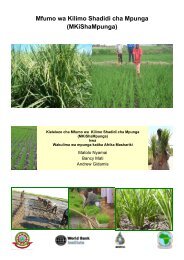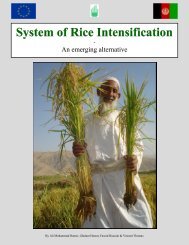EFFECT OF THE SYSTEM OF RICE INTENSIFICATION (SRI) ON ...
EFFECT OF THE SYSTEM OF RICE INTENSIFICATION (SRI) ON ...
EFFECT OF THE SYSTEM OF RICE INTENSIFICATION (SRI) ON ...
Create successful ePaper yourself
Turn your PDF publications into a flip-book with our unique Google optimized e-Paper software.
The following main topics were examined within each household: household size, income sources,<br />
use of organic amendments, compost production, agricultural practices (traditional vs. <strong>SRI</strong>). This<br />
was done in order to identify their livelihood strategies.<br />
8.3 Statistical analyses<br />
All data analyses were carried out in Excel 2002 and in the statistical package “R” 2.8.1. Significant<br />
differences and correlations were tested between soil, household and rice yield data.<br />
9. Results and discussion<br />
9.1 Soil pH, Carbon and Nitrogen – the biophysical environment<br />
9.1.2 pH<br />
The average pH value for the soil was 4.53 and no significant difference was found from farmer to<br />
farmer or village to village. Such a low pH really illustrates how acidic the soils are of the target<br />
area and the surrounding area of Prey Veng. See appendix D for details on pH for every farmer.<br />
Normally the soil type of Prey Veng has a higher pH according to the CASC (Cambodian<br />
Agronomic Soil Classification System 5 ) of pH 5.4 (White et al., 2000). The given soil type in the<br />
target area and one of Cambodia’s most important rice soils is termed the Prateah Lang group<br />
(White et al., 1997) a Plinthustalf (Pheav et al., 2005) sandy loam. This low pH value indicates that<br />
the availability of nutrients and microbial activity are rather limited compared to an optimum pH of<br />
5.5-7.0 (Brady & Weil, 1999b). With a low pH there can be risks of Aluminium toxicity (Brady &<br />
Weil, 1999b) but this scope has not been a part of this project and has therefore not been examined.<br />
The potential of liming the acid soils with e.g. calcite (CaCO3) to increase pH (Brady & Weil,<br />
1999b) does not seem to be an option for the target farmers and farmers in general in Cambodia as<br />
such an investment would most likely be too expensive for them.<br />
In general though as the flooding of rice field takes place the pH will turn towards neutrality and<br />
can change the pH of the soil with 0.5 to 2 pH units all depending on the acidity prior to flooding<br />
5 CASC was developed by CIAP (Cambodia-IRRI-Australia-Project) in the 1990ies within a very large agricultural<br />
project for several years by Cambodian and international experts in order to develop an easy to use and applicable<br />
system to use for farmers and technicians in order to key soils and set up management methods (White et al., 2000).<br />
instead of an older but more complex system developed by Crocker in the early sixties (Oberthür et al., 2000).<br />
39



